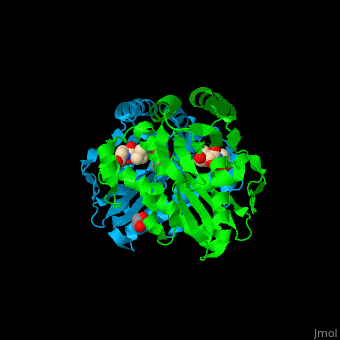Pantothenate kinase
From Proteopedia
FunctionPantothenate kinase (PanK) phosphorylates pantothenate (vitamin B5) (PAU) to form 4’-phosphopantothenate (PPT) using ATP as phosphate source. This is the first step in coenzyme A biosynthesis[1]. Three types of PanK are known.
DiseaseMutations in PanK II cause the autosomal-recessive disorder Pantothenate kinase-associated neurodegeneration[2]. Structural highlightsPantothenate binds in a buried pocket at the PanK dimer interface[3]. 3D structures of pantothenate kinasePantothenate kinase 3D structures
|
| |||||||||||
References
- ↑ . PanK is regulated by feedback inhibition by CoA and its thioesters.PMID:9890959
- ↑ Pellecchia MT, Valente EM, Cif L, Salvi S, Albanese A, Scarano V, Bonuccelli U, Bentivoglio AR, D'Amico A, Marelli C, Di Giorgio A, Coubes P, Barone P, Dallapiccola B. The diverse phenotype and genotype of pantothenate kinase-associated neurodegeneration. Neurology. 2005 May 24;64(10):1810-2. PMID:15911822 doi:http://dx.doi.org/10.1212/01.WNL.0000161843.52641.EC
- ↑ Hong BS, Yun MK, Zhang YM, Chohnan S, Rock CO, White SW, Jackowski S, Park HW, Leonardi R. Prokaryotic type II and type III pantothenate kinases: The same monomer fold creates dimers with distinct catalytic properties. Structure. 2006 Aug;14(8):1251-61. PMID:16905099 doi:10.1016/j.str.2006.06.008

